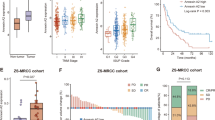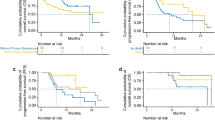Abstract
Immunotherapy plus tyrosine kinase inhibitor (IO-TKI) has become the standard first-line therapy for advanced renal cell carcinoma (RCC). However, the modest response rate of IO-TKI therapy and the absence of biomarkers limited the selection of treatment strategies for RCC patients. There were three cohorts enrolled: two from our facility (ZS-MRCC and ZS-HRRCC) and one from a clinical study (JAVELIN-101). By RNA sequencing, the expression of ADAM9 in each sample was measured. By flow cytometry and immunohistochemistry, immune infiltration and T cell function were examined. Primary outcomes were established as treatment response and progression-free survival (PFS). Patients with low-ADAM9 expression had a higher objective response rate (56.5% vs 13.6%, P = 0.01) and longer PFS in both cohorts. In the ZS-HRRCC cohort, the expression of ADAM9 was associated with increased tumor-infiltrating T cells, which was proved by immunohistochemistry (P < 0.05) and flow cytometry (Spearman’s ρ = 0.42, P < 0.001). In the high-ADAM9 group, CD8+ and CD4+ T cells revealed an exhausted phenotype with decreased GZMB (Spearman’s ρ = − 0.31, P = 0.05, and Spearman’s ρ = − 0.49, P < 0.001, respectively), and fewer Macrophages were identified. A predictive RFscore was further constructed by random forest approach, involving ADAM9 and immunologic genes. Only in the subgroup with the lower RFscore did IO-TKI outperform TKI monotherapy. High-ADAM9 expression was associated with immunosuppression and IO-TKI resistance. Expression of ADAM9 was also associated with the exhaustion and dysfunction of T cells. ADAM9-based RFscore has the potential to be used as a biomarker to distinguish the optimal patient treatment methods between IO-TKI and TKI monotherapy.




Similar content being viewed by others
Data Availability
The datasets in the current study are open to the public at the TCGA (https://xena.ucsc.edu/) and Javelin Renal 101 clinical trial (https://www.nature.com/articles/s41591-020-1044-8). Further inquiries can be directed to the corresponding authors. The data of our cohorts that support the results of this study are available from the corresponding author upon reasonable request.
References
Braun DA, Hou Y, Bakouny Z, Ficial M, Sant’ Angelo M, Forman J et al (2020) Interplay of somatic alterations and immune infiltration modulates response to PD-1 blockade in advanced clear cell renal cell carcinoma. Nat Med 26:909–918. https://doi.org/10.1038/s41591-020-0839-y
Carretero-Gonzalez A, Lora D, Martin Sobrino I, Saez Sanz I, Bourlon MT, Anido Herranz U et al (2020) The value of PD-L1 expression as predictive biomarker in metastatic renal cell carcinoma patients: a meta-analysis of randomized clinical trials. Cancers (Basel) 12. https://doi.org/10.3390/cancers12071945
Choueiri TK, Powles T, Burotto M, Escudier B, Bourlon MT, Zurawski B et al (2021) Nivolumab plus cabozantinib versus sunitinib for advanced renal-cell carcinoma. N Engl J Med 384:829–841. https://doi.org/10.1056/NEJMoa2026982
Eisenhauer EA, Therasse P, Bogaerts J, Schwartz LH, Sargent D, Ford R et al (2009) New response evaluation criteria in solid tumours: revised RECIST guideline (version 1.1). Eur J Cancer 45:228–247. https://doi.org/10.1016/j.ejca.2008.10.026
Fritzsche FR, Wassermann K, Jung M, Tolle A, Kristiansen I, Lein M et al (2008) ADAM9 is highly expressed in renal cell cancer and is associated with tumour progression. BMC Cancer 8:179. https://doi.org/10.1186/1471-2407-8-179
Fry JL, Toker A (2010) Secreted and membrane-bound isoforms of protease ADAM9 have opposing effects on breast cancer cell migration. Cancer Res 70:8187–8198. https://doi.org/10.1158/0008-5472.CAN-09-4231
Gill DM, Hahn AW, Hale P, Maughan BL (2018) Overview of current and future first-line systemic therapy for metastatic clear cell renal cell carcinoma. Curr Treat Options Oncol 19:6. https://doi.org/10.1007/s11864-018-0517-1
Goldman MJ, Craft B, Hastie M, Repecka K, McDade F, Kamath A et al (2020) Visualizing and interpreting cancer genomics data via the Xena platform. Nat Biotechnol 38:675–678. https://doi.org/10.1038/s41587-020-0546-8
Kim JM, Jeung HC, Rha SY, Yu EJ, Kim TS, Shin YK et al (2014) The effect of disintegrin-metalloproteinase ADAM9 in gastric cancer progression. Mol Cancer Ther 13:3074–3085. https://doi.org/10.1158/1535-7163.MCT-13-1001
Kohga K, Takehara T, Tatsumi T, Ishida H, Miyagi T, Hosui A et al (2010) Sorafenib inhibits the shedding of major histocompatibility complex class I-related chain A on hepatocellular carcinoma cells by down-regulating a disintegrin and metalloproteinase 9. Hepatology 51:1264–1273. https://doi.org/10.1002/hep.23456
Lin CY, Chen HJ, Huang CC, Lai LC, Lu TP, Tseng GC et al (2014) ADAM9 promotes lung cancer metastases to brain by a plasminogen activator-based pathway. Cancer Res 74:5229–5243. https://doi.org/10.1158/0008-5472.CAN-13-2995
Lin CY, Cho CF, Bai ST, Liu JP, Kuo TT, Wang LJ et al (2017) ADAM9 promotes lung cancer progression through vascular remodeling by VEGFA, ANGPT2, and PLAT. Sci Rep 7:15108. https://doi.org/10.1038/s41598-017-15159-1
Lin YS, Kuo TT, Lo CC, Cheng WC, Chang WC, Tseng GC et al (2021) ADAM9 functions as a transcriptional regulator to drive angiogenesis in esophageal squamous cell carcinoma. Int J Biol Sci 17:3898–3910. https://doi.org/10.7150/ijbs.65488
Ljungberg B, Albiges L, Abu-Ghanem Y, Bedke J, Capitanio U, Dabestani S et al (2022) European association of urology guidelines on renal cell carcinoma: the 2022 update. Eur Urol 82:399–410. https://doi.org/10.1016/j.eururo.2022.03.006
Mazzocca A, Coppari R, De Franco R, Cho JY, Libermann TA, Pinzani M et al (2005) A secreted form of ADAM9 promotes carcinoma invasion through tumor-stromal interactions. Cancer Res 65:4728–4738. https://doi.org/10.1158/0008-5472.CAN-04-4449
McDermott DF, Huseni MA, Atkins MB, Motzer RJ, Rini BI, Escudier B et al (2018) Clinical activity and molecular correlates of response to atezolizumab alone or in combination with bevacizumab versus sunitinib in renal cell carcinoma. Nat Med 24:749–757. https://doi.org/10.1038/s41591-018-0053-3
Micocci KC, Moritz MN, Lino RL, Fernandes LR, Lima AG, Figueiredo CC et al (2016) ADAM9 silencing inhibits breast tumor cells transmigration through blood and lymphatic endothelial cells. Biochimie 128–129:174–182. https://doi.org/10.1016/j.biochi.2016.08.006
Motzer R, Alekseev B, Rha SY, Porta C, Eto M, Powles T et al (2021) Lenvatinib plus pembrolizumab or everolimus for advanced renal cell carcinoma. N Engl J Med 384:1289–1300. https://doi.org/10.1056/NEJMoa2035716
Motzer RJ, Penkov K, Haanen J, Rini B, Albiges L, Campbell MT et al (2019) Avelumab plus axitinib versus sunitinib for advanced renal-cell carcinoma. N Engl J Med 380:1103–1115. https://doi.org/10.1056/NEJMoa1816047
Motzer RJ, Robbins PB, Powles T, Albiges L, Haanen JB, Larkin J et al (2020) Avelumab plus axitinib versus sunitinib in advanced renal cell carcinoma: biomarker analysis of the phase 3 JAVELIN Renal 101 trial. Nat Med 26:1733–1741. https://doi.org/10.1038/s41591-020-1044-8
Motzer RJ, Tannir NM, McDermott DF, Aren Frontera O, Melichar B, Choueiri TK et al (2018) Nivolumab plus ipilimumab versus sunitinib in advanced renal-cell carcinoma. N Engl J Med 378:1277–1290. https://doi.org/10.1056/NEJMoa1712126
Oria VO, Lopatta P, Schilling O (2018) The pleiotropic roles of ADAM9 in the biology of solid tumors. Cell Mol Life Sci 75:2291–2301. https://doi.org/10.1007/s00018-018-2796-x
Posadas EM, Limvorasak S, Figlin RA (2017) Targeted therapies for renal cell carcinoma. Nat Rev Nephrol 13:496–511. https://doi.org/10.1038/nrneph.2017.82
Rini BI, Plimack ER, Stus V, Gafanov R, Hawkins R, Nosov D et al (2019) Pembrolizumab plus axitinib versus sunitinib for advanced renal-cell carcinoma. N Engl J Med 380:1116–1127. https://doi.org/10.1056/NEJMoa1816714
Sarkar S, Zemp FJ, Senger D, Robbins SM, Yong VW (2015) ADAM-9 is a novel mediator of tenascin-C-stimulated invasiveness of brain tumor-initiating cells. Neuro Oncol 17:1095–1105. https://doi.org/10.1093/neuonc/nou362
Scribner JA, Hicks SW, Sinkevicius KW, Yoder NC, Diedrich G, Brown JG et al (2022) Preclinical evaluation of IMGC936, a next-generation maytansinoid-based antibody-drug conjugate targeting ADAM9-expressing tumors. Mol Cancer Ther 21:1047–1059. https://doi.org/10.1158/1535-7163.MCT-21-0915
Sung H, Ferlay J, Siegel RL, Laversanne M, Soerjomataram I, Jemal A et al (2021) Global cancer statistics 2020: GLOBOCAN estimates of incidence and mortality worldwide for 36 cancers in 185 countries. CA Cancer J Clin 71:209–249. https://doi.org/10.3322/caac.21660
Vano YA, Elaidi R, Bennamoun M, Chevreau C, Borchiellini D, Pannier D et al (2022) Nivolumab, nivolumab-ipilimumab, and VEGFR-tyrosine kinase inhibitors as first-line treatment for metastatic clear-cell renal cell carcinoma (BIONIKK): a biomarker-driven, open-label, non-comparative, randomised, phase 2 trial. Lancet Oncol 23:612–624. https://doi.org/10.1016/S1470-2045(22)00128-0
Wang J, Liu L, Bai Q, Ou C, Xiong Y, Qu Y et al (2019) Tumor-infiltrating neutrophils predict therapeutic benefit of tyrosine kinase inhibitors in metastatic renal cell carcinoma. Oncoimmunology 8:e1515611. https://doi.org/10.1080/2162402X.2018.1515611
Wang J, Zhang S, Wang Y, Zhu Y, Xu X, Guo J (2023) Alternative complement pathway signature determines immunosuppression and resistance to immunotherapy plus tyrosine kinase inhibitor combinations in renal cell carcinoma. Urol Oncol 41:51 e13–51 e23. https://doi.org/10.1016/j.urolonc.2022.09.009
Wolfsberg TG, Primakoff P, Myles DG, White JM (1995) ADAM, a novel family of membrane proteins containing A disintegrin and metalloprotease domain: multipotential functions in cell-cell and cell-matrix interactions. J Cell Biol 131:275–278. https://doi.org/10.1083/jcb.131.2.275
Yi M, Jiao D, Qin S, Chu Q, Wu K, Li A (2019) Synergistic effect of immune checkpoint blockade and anti-angiogenesis in cancer treatment. Mol Cancer 18:60. https://doi.org/10.1186/s12943-019-0974-6
Zigrino P, Nischt R, Mauch C (2011) The disintegrin-like and cysteine-rich domains of ADAM-9 mediate interactions between melanoma cells and fibroblasts. J Biol Chem 286:6801–6807. https://doi.org/10.1074/jbc.M110.168617
Acknowledgements
We thank those authors who released and shared their datasets on the TCGA databases and Javelin Renal 101 clinical trial.
Funding
This study was funded by grants from the National Natural Science Foundation of China (81700660, 81902898, 81772696, 81974393), Shanghai Sailing Program (19YF1407900), and Experimental Animal Project of Shanghai Science and Technology Commission (19140905200). All these study sponsors have no roles in the study design and in the collection, analysis, and interpretation of data.
Author information
Authors and Affiliations
Contributions
Xianglai Xu and Jiajun Wang conceived and designed the study. Jiajun Wang, Zhaoyi Chen, and Ying Wang contributed to the acquisition, analysis, and interpretation of data. Jiajun Wang and Ying Wang performed the statistical analysis. Jiajun Wang wrote the paper. Yanjun Zhu, Xianglai Xu, and Jianming Guo reviewed the manuscript. Ying Wang and Yanjun Zhu provided technical and material support. Jiajun Wang, Yanjun Zhu, Xianglai Xu, and Jianming Guo contributed to the funding obtaining. Jianming Guo contributed to study supervision. All authors read and approved the manuscript.
Corresponding authors
Ethics declarations
Ethics approval and consent to participate
The study followed the Declaration of Helsinki and was approved by the Clinical Research Ethics Committee of Zhongshan Hospital, Fudan University (B2021-119). Informed consent was obtained from each participant.
Competing interests
The authors declare no competing interests.
Additional information
Publisher's Note
Springer Nature remains neutral with regard to jurisdictional claims in published maps and institutional affiliations.
Supplementary Information
Below is the link to the electronic supplementary material.
251_2022_1292_MOESM1_ESM.jpg
Supplementary file1 Fig. S1 (A-B) The relationship between stage (A) or grade (B) and the expression of ADAM9. P values, Kruskal-Wallis H test. (C) PFS according to ADAM9 expression in the TxNxM1 cases from TCGA cohort. P value, Kaplan-Meier analysis, and log-rank test. (D-E) Association between TILs and ADAM9 expression by immunohistochemistry (D) and flow cytometry (E) in the ZS-HRCC cohort. ρ and P values, Spearman's rank-order correlation (JPG 732 KB)
Rights and permissions
Springer Nature or its licensor (e.g. a society or other partner) holds exclusive rights to this article under a publishing agreement with the author(s) or other rightsholder(s); author self-archiving of the accepted manuscript version of this article is solely governed by the terms of such publishing agreement and applicable law.
About this article
Cite this article
Xu, X., Wang, Y., Chen, Z. et al. Unfavorable immunotherapy plus tyrosine kinase inhibition outcome of metastatic renal cell carcinoma after radical nephrectomy with increased ADAM9 expression. Immunogenetics 75, 133–143 (2023). https://doi.org/10.1007/s00251-022-01292-3
Received:
Accepted:
Published:
Issue Date:
DOI: https://doi.org/10.1007/s00251-022-01292-3




